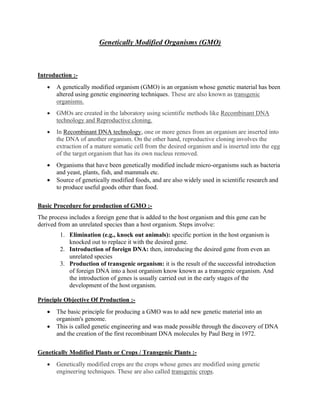
GMO.pdf
- 1. Genetically Modified Organisms (GMO) Introduction :- • A genetically modified organism (GMO) is an organism whose genetic material has been altered using genetic engineering techniques. These are also known as transgenic organisms. • GMOs are created in the laboratory using scientific methods like Recombinant DNA technology and Reproductive cloning. • In Recombinant DNA technology, one or more genes from an organism are inserted into the DNA of another organism. On the other hand, reproductive cloning involves the extraction of a mature somatic cell from the desired organism and is inserted into the egg of the target organism that has its own nucleus removed. • Organisms that have been genetically modified include micro-organisms such as bacteria and yeast, plants, fish, and mammals etc. • Source of genetically modified foods, and are also widely used in scientific research and to produce useful goods other than food. Basic Procedure for production of GMO :- The process includes a foreign gene that is added to the host organism and this gene can be derived from an unrelated species than a host organism. Steps involve: 1. Elimination (e.g., knock out animals): specific portion in the host organism is knocked out to replace it with the desired gene. 2. Introduction of foreign DNA: then, introducing the desired gene from even an unrelated species 3. Production of transgenic organism: it is the result of the successful introduction of foreign DNA into a host organism know known as a transgenic organism. And the introduction of genes is usually carried out in the early stages of the development of the host organism. Principle Objective Of Production :- • The basic principle for producing a GMO was to add new genetic material into an organism's genome. • This is called genetic engineering and was made possible through the discovery of DNA and the creation of the first recombinant DNA molecules by Paul Berg in 1972. Genetically Modified Plants or Crops / Transgenic Plants :- • Genetically modified crops are the crops whose genes are modified using genetic engineering techniques. These are also called transgenic crops.
- 2. • The main goal of producing GMOs is to increase the yield of the crop and to produce disease-resistant crops. • An example of a genetically modified crop is Golden Rice. It was genetically modified to generate beta-carotene twenty times more than the previous varieties of rice. Golden rice is intended for Asia. One more rice variety was also created to fight iron deficiency. A gene from the bean plant is taken and inserted into the rice gene, and the resultant rice helps to fight iron deficiency. • Another organism that was produced through genetic engineering is Arabidopsis thaliana. • Other examples are – Bt brinjal, Bt tomato, Bt cotton, GM maize, Soybean. Genetically Modified Microbes :- Bacteria : E. coli for insulin production • Transformation: the process of introduction of foreign DNA into a cell, • Requires a competent cell, which is introduced in E. coli using calcium chloride. • After the treatment, foreign DNA becomes capable of introduction into the competent cell and thus later integrate into the genome. • Disadvantage: less efficient, require selection marker • Advantage: easy to perform, cheap • Herbert and Boyer in 1978 used the same competent cell of E. coli to produce insulin which is used to cure diabetic patients. Genetically Modified Mammals :- • Ralph L. Brinster and Richard Palmiter developed the techniques responsible for transgenic mice, rats, rabbits, sheep, and pigs in the early 1980s. • They established many of the first transgenic models of human disease, including the first carcinoma caused by a transgene. • The process of genetically engineering animals is a slow, tedious, and expensive process. However, new technologies are making genetic modifications easier and more precise. Advantages of Genetically Modified Organisms (GMO) • Better nutritional values • Food has a longer shelf life • Because of increased shelf life, it is easy to transport • Reduced use of herbicides and pesticides • Used in pharmaceutics, to produce vaccines, insulins, and disease treatment • Transgenic mice have wide application in research • Higher yield of crops • The desired trait in crops can be monitored and controlled
- 3. Disadvantages of Genetically Modified Organisms (GMO) • Associated ethical issue • Can be complex to be understood for farmers • Can introduce antibiotic resistance • More legal liabilities for farmers growing GMO • No independent research can be done • Genes pass into other plants species • Lack of awareness among consumers • Introducing GM varieties in new habitats could result in the transfer of new genes to the traditional varieties and wild relatives of the crop. It could also change ecosystems by affecting nontarget organisms.